Nine Years of Bagrada Bug on Desert Cole Crops
John C. Palumbo, Yuma Agricultural Center
The bagrada bug, Bagrada hilaris, became a major pest of cole crops in the fall of 2010 where widespread outbreaks of this invasive stinkbug pest were reported throughout the desert growing areas in September and October. The resulting stand losses and yield/quality reductions to broccoli, cauliflower, cabbage and other Brassica crops were considered economically significant. To document the impact of annual infestations, we have surveyed produce growers and PCAs from Yuma Co., Maricopa Co. and Imperial Co., CA on an annual basis since 2010 to estimate the severity of bagrada bug on direct-seeded and transplanted cole crops, and the intensity of chemical management required to control it.
In the surveys, PCAs and growers were anonymously requested to estimate the fall acreage (AugustNovember) they managed, and of those acres, the percentage where bagrada bug populations were present, what percentage required insecticide treatments and how often. In addition, they were asked to estimate the average percent stand losses and plant injury caused by bagrada bug infestations. Finally, PCAs and growers were asked to list the insecticide products they found to be effective in controlling bagrada bug adults when applied as either sprinkler chemigations or foliar sprays. Information was collected separately for direct-seeded and transplanted cole crops. Beginning in 2015, we asked for information specific to the use of Nipsit seed treatments in conventional production. Table 1 shows the number of PCAs who participated in the surveys each year and the acres their estimates represented.
Table 1. Number of PCA respondents and acreage estimated in bagrada surveys, 2010-18.
|
Season |
No. PCAs responding |
Acres Estimated in Survey |
|
|
|
Direct-seeded |
Transplanted |
Total |
||
|
2010 |
17 |
9310 |
4610 |
13,920 |
|
2011 |
13 |
6210 |
3450 |
9660 |
|
2012 |
19 |
6290 |
4595 |
10,885 |
|
2013 |
21 |
7255 |
5435 |
12,690 |
|
2014 |
19 |
6080 |
8080 |
14,160 |
|
2015 |
20 |
6700 |
6400 |
13,100 |
|
2016 |
22 |
4423 |
7985 |
12,408 |
|
2017 |
27 |
10,245 |
9170 |
19,415 |
|
2018 |
27 |
8980 |
7488 |
16,428 |
Since the initial bagrada bug outbreaks in 2010 this invasive stink bug has become an important, established pest on desert cole crops. However, seasonal population abundance studies of adults infesting non-treated broccoli plants at the Yuma Ag Center (Fig 1) show that bagrada bug infestations in 2018-19 were very low and ranked among the lowest we’ve experienced since it first appeared in the desert. Furthermore, bagrada bug population abundance during the fall on non-treated broccoli plots have been consistently declining since 2013 (Fig. 2). To further support this decline in seasonal activity, results from the PCA surveys indicated that bagrada populations were considerably lighter in 2017 and 2018. Prior to 2016, bagrada bug infestations were present on greater than 90% and 85% of the direct seeded and transplanted cole crop acreage, respectively (Fig 3). However, in the last two fall seasons, the percentage of acreage treated for bagrada adults in direct-seeded and transplanted crops was less than 40% of the total acreage. In both crops, PCAs treated a higher percentage of acres than where the pest was present, reflecting the preventative approach to bagrada management. This is not surprising given the importance of preventing bagrada feeding during stand establishment to reduce stand losses and plant injury.
This is further reflected by the proportionately large number of acres chemigated an average of 1.5 times since the initial outbreaks (Table 2). However, in 2018 for the first time, less than 50% of the direct seeded acreage was chemigated. Slightly more than 40% of the transplanted acreage was chemigated in 2018. Once sprinkler pipe is removed from the field, management for bagrada remained typically remains intensive. For example, greater than 80% of the reported acres were sprayed an average of 2.2 times in direct seeded-crops and over 76% of transplanted crops were sprayed almost 2 times from 2010-2015. However, in 2018, the number of spray treatments (0.3-0.5) were down considerably for both direct seeded and transplanted crops, and the acreage receiving sprays was below 20 and 10% respectively. When the number of chemigations and foliar sprays are combined, PCAs treated fewer times in 2018 for bagrada compared to the previous eight years. In fact, the number of chemigations and sprays in 2018 were more than 4-fold fewer than when the bagrada first showed up in 2010.
We’re uncertain why populations have been declining over the past few years but may in part be a due to aggressive preventative control measures (particularly from 2010-2014), use of insecticide seed treatments, changes in the cropping system (fewer cotton acres), improved bagrada control in nurseries and greenhouses, local drought conditions, and impact of natural enemies (e.g., predators, pathogens) in non-crop landscapes. Collectively, these management and environmental factors may have provided areawide population suppression both during the produce season as well as during the summer months when bagrada must survive on alternative weed and crop hosts.
Estimates of stand losses from bagrada bug infestations at stand establishment in both direct-seeded and transplanted crops have decreased considerably over the past 9 years (Table 3). Stand losses in 2017 were quite low relative to the previous years, and consistent with the reduced presence of bagrada bugs in commercial crops. Plant injury, defined as plants with multiple heads, forked terminals, and/or blind terminals resulting from bagrada feeding, was the lowest recorded since 2010 for both direct-seeded and transplanted crops. Similarly, total losses for direct seeded and transplanted crops were lower than in any previous year, and down significantly compared with the initial outbreaks in 2010. These reported losses are consistent with stand losses and plant injury measured in trials conducted at the Yuma Ag Center over the past seven years.
Effective Insecticides:
Over the past 9 years, growers and PCAs reported using pyrethroids almost exclusively to control bagrada bugs during stand establishment via sprinkler chemigation (Figure 4). Among the insecticide active ingredients (AI) reported as effective, bifenthrin (Brigade, Bifenture, Fanfare, Sniper, Hero and Discipline) has been the most commonly reported, followed by lambda-cyhalothrin (Warrior II, Silencer, Besiege, Lambda-Cy) and zeta-cypermethrin (Mustang, Hero). Several other pyrethroids were reported as being effective including esfenvalerate (Asana), permethrin (Perm-Up), and beta-cyfluthrin (Baythroid) but were used by relatively fewer PCAs. One PCA reported using imidacloprid (Alias) in 2010, but since then no use of this AI has been reported. In 2013 and 2014, PCAs reported using Endigo, an in-can mixture of thiamethoxam and lambda-cyhalothrin, but none has been reported since 2014. In general, comments provided on the survey suggested that pyrethroid chemigations appeared to provide effective knockdown control of adults, but under heavy bagrada bug pressure re-application was often necessary after 2-3 days.
In contrast, a broader array of AIs has been reported for use against bagrada bugs when applied as foliar sprays on established stands after the sprinklers were removed. Pyrethroids were reported as the most effective chemistry used by PCAs (Figure 5). Bifenthrin was the most commonly used AI, followed by lambda-cyhalothin, zeta-cypermethrin, esfenvaluate and permethrin. Among the alternative chemistries used, dinotefuran, methomyl and chlorpyrifos were reported to be effective against bagrada adults by PCAs. Several other neonicotinoids and pyrethroids were reported less frequently. Reports of neonicotinoid usage for bagrada control decreased in 2017 consistent with fewer spray reported (Table 2). These estimates are consistent with results from efficacy trials conducted at Yuma Ag Center where products that have contact activity (i.e., Pyrethroids, OP/Carbamates) have provided the most effective control against bagrada adults on both directseeded and transplanted cole crops.
Over the past four growing seasons, we asked PCAs and growers about their experiences with the newly registered insecticide seed treatment for broccoli, NipsIt (containing clothianidin). Several PCAs reported using Nipsit and the percentage of acreage planted with the seed treatment peaked in 2016 with about 2/3 of reported acreage was planted with NipsIt (Table 4). In 2018, we observed a significant decrease in the Nipsit acreage and number of PCAs using the product. Based on the performance rating criteria, PCAs reported that Nipsit provided good-excellent control of bagrada adults at stand establishment. In 2018, the PCA’s reported that product was extremely effective in controlling bagrada bug adults moving into new broccoli stands. These results are consistent with multiple years of research at YAC evaluating Nipsit broccoli against bagrada during stand establishment.
Acknowledgement: Special thanks go out to all the PCAs and growers who took time away from their busy schedules to participate in these surveys over the past nine. Without your efforts, this historical data would not exist.
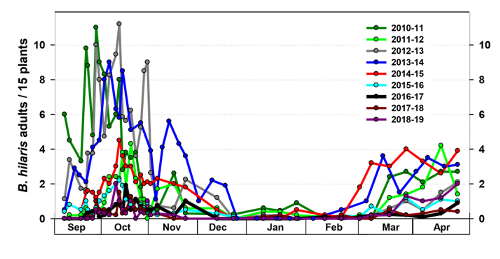
Figure 1. Seasonal bagrada bug abundance (adults/15 plants) in non-treated broccoli at the Yuma Agricultural Center from September 2010 through April 2019.
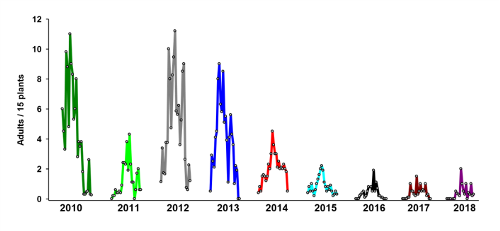
Figure 2. Fall bagrada bug abundance (adults/15 plants) in non-treated broccoli at the Yuma Agricultural Center during Sep-Nov, 2010-2018.

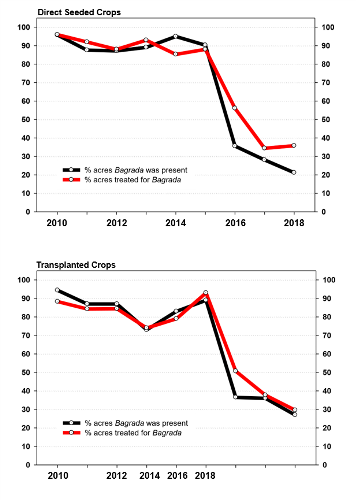
Figure 3. Percentage of acres where bagrada bugs were present and acres that required insecticide treatment for their control in direct-seeded (top) and transplanted cole crops (bottom), 2010-18.
|
Table 2.Impact of Bagrada bug on direct seeded cole crops- based on chemical control. |
|
|
|||||||
|
|
|
|
Direct-seeded |
|
|
|
|||
|
Chemical Control |
2010 |
2011 |
2012 |
2013 |
2014 |
2015 |
2016 |
2017 |
2018 |
|
% acres chemigated |
73.8 |
75.2 |
85.5 |
87.1 |
75.6 |
85.9 |
52.3 |
54.8 |
44.7 |
|
Avg. no. chemigations |
1.6 |
1.6 |
1.6 |
1.5 |
1.6 |
1.3 |
1.2 |
1.0 |
0.7 |
|
% acres sprayed w/ insecticide |
90.0 |
87.0 |
86.8 |
88.5 |
76.3 |
60.1 |
34.7 |
24.1 |
18.7 |
|
Avg. no. sprays |
2.7 |
1.8 |
2.5 |
2.5 |
2.2 |
1.4 |
1.0 |
0.6 |
0.5 |
|
Total no. applications |
4.3 |
3.4 |
4.1 |
4.0 |
3.8 |
2.7 |
2.2 |
1.6 |
1.2 |
|
Table 3.Impact of Bagrada bug o |
n desert c |
ole crops |
- based |
on chem |
ical cont |
rol. |
|
|
|
|
Chemical Control |
|
|
|
Transplanted |
|
|
|
||
|
2010 |
2011 |
2012 |
2013 |
2014 |
2015 |
2016 |
2017 |
2018 |
|
|
% acres chemigated |
60.6 |
72.0 |
65.1 |
67.4 |
64.8 |
79.3 |
55.1 |
49.3 |
41.5 |
|
Avg. no. chemigations |
1.4 |
1.3 |
1.1 |
1.3 |
1.4 |
1.3 |
1.0 |
0.9 |
0.5 |
|
% acres sprayed w/ insecticide |
85.6 |
80.8 |
82.8 |
67.9 |
70.8 |
71.4 |
34.6 |
24.0 |
8.9 |
|
Avg. no. sprays |
2.1 |
1.8 |
1.8 |
1.9 |
1.5 |
1.8 |
0.9 |
0.7 |
0.3 |
|
Total no. applications |
3.5 |
3.1 |
2.9 |
3.2 |
2.9 |
3.1 |
2.0 |
1.6 |
0.8 |
Table 4. Impact of Bagrada bug on direct-seeded and transplanted crops- based on feeding injury.
![]()
Direct-seeded Crops Transplanted Crops
|
Season |
Avg Stand loss (%) |
Avg plant injury (%) |
Total crop loss (%) |
Avg Stand loss (%) |
Avg plant injury (%) |
Total crop loss (%) |
|
2010 |
6.3 |
8.0 |
14.3 |
3.1 |
4.6 |
7.7 |
|
2011 |
2.5 |
4.2 |
6.7 |
1.5 |
3.9 |
5.4 |
|
2012 |
2.8 |
3.2 |
6.0 |
1.4 |
2.1 |
3.5 |
|
2013 |
3.9 |
7.9 |
11.8 |
1.7 |
5.8 |
7.5 |
|
2014 |
3.2 |
5.5 |
8.7 |
1.6 |
3.1 |
4.7 |
|
2015 |
2.6 |
2.9 |
5.5 |
1.6 |
3.6 |
5.2 |
|
2016 |
1.6 |
3.0 |
4.6 |
0.6 |
2.0 |
2.6 |
|
2017 |
0.3 |
1.0 |
1.3 |
0.6 |
1.4 |
2.0 |
|
2018 |
0.4 |
0.8 |
1.2 |
0.3 |
0.7 |
1.0 |
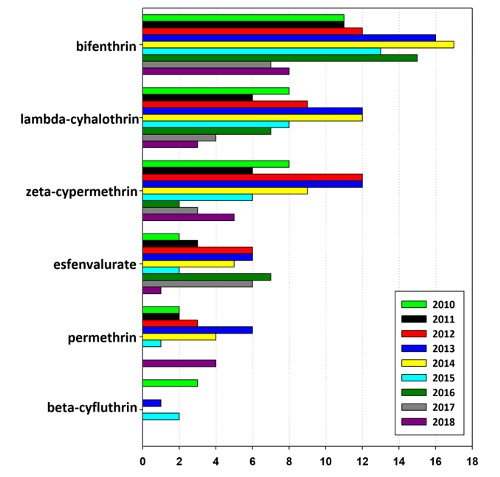
Figure 4. Insecticide AIs reported as effective against bagrada adult infestations when applied as chemigation treatments during stand establishment on cole crop fields in Yuma, Imperial and Maricopa Cos. in 2010-2018.
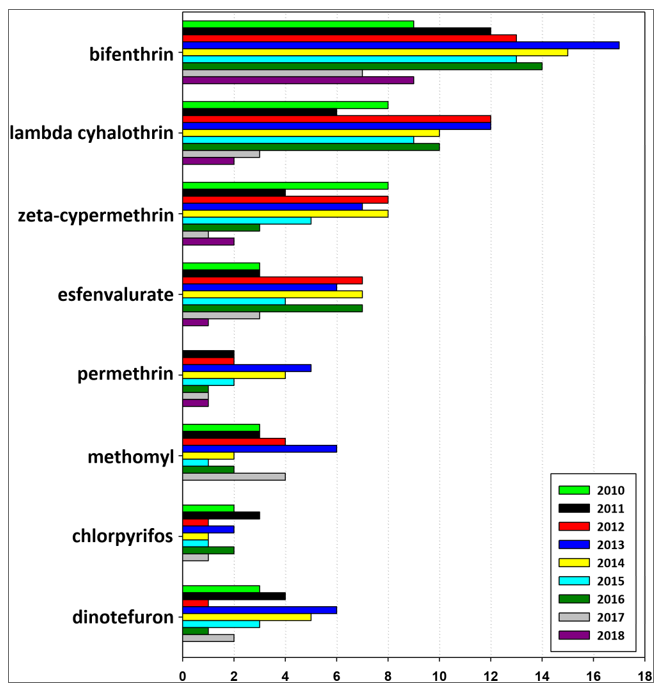
Figure 5. Insecticide AI s reported as effective against bagrada bug adult infestations when applied as foliar spray treatments on established cole crop fields in Yuma, Imperial and Maricopa Cos. in 2010-2018.
Table 4. Estimated usage of the Nipsit broccoli seed treatment (clothianidin) and its performances against bagrada bugs, fall 2015-18.
|
Fall Season |
No. PCAs using Nipsit |
Acres planted with Nipsit |
% of Total[1]Acres Reported |
Performance2Rating |
|
2015 |
8 |
2760 |
41.2 |
4.5 |
|
2016 |
7 |
2950 |
66.7 |
4.4 |
|
2017 |
9 |
5750 |
56.1 |
4.1 |
|
2018 |
2 |
1100 |
7.4 |
4.5 |
[1] Total acres of broccoli reported in 2015=6700; 2016=4423; in 2017=10,245; 2018=8980. 2 Rating based on a scale of 1-5; with 1=no control; 2= poor control; 3= fair control; 4= good control; and 5=Excellent control.